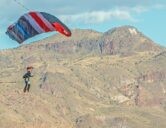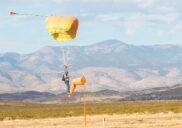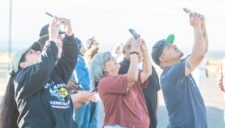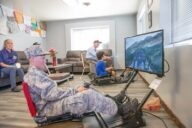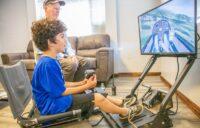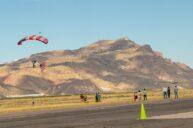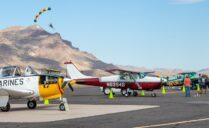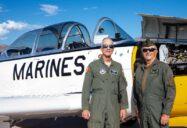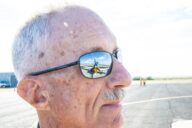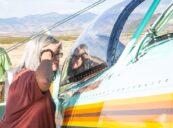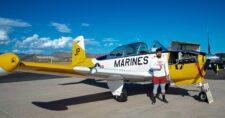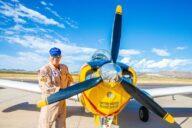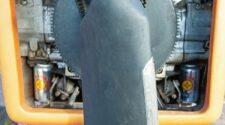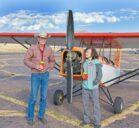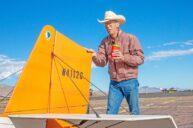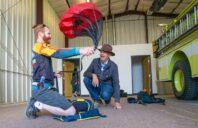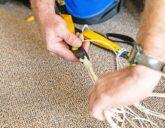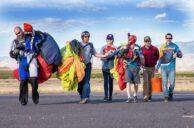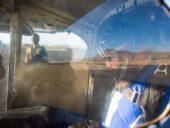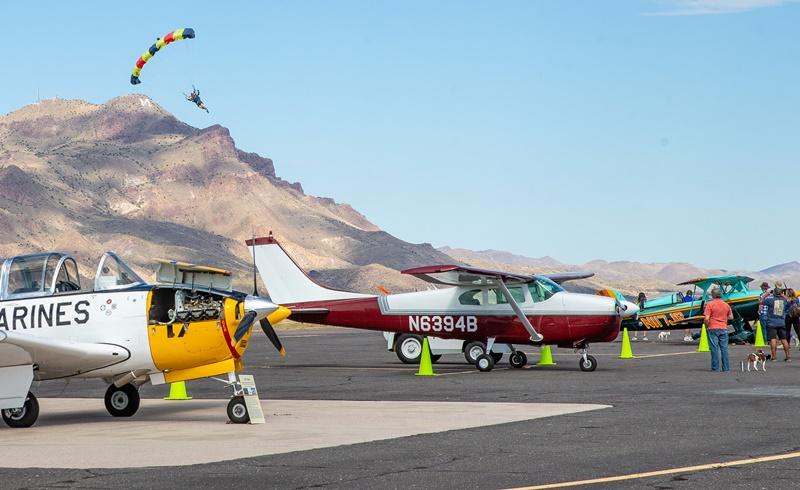
Skydiver Ben Sheffield zeroes in on a landing spot with the Magdalena Mountains in the background.
Russell Huffman | El Defensor Chieftain
There was plenty of fanfare, and the cellphones were locked on target as skydiver Alex Little left the airplane at 5,500 feet Saturday morning to present the American flag and kick start the 13th annual Capt. Laura S. Haines ‘M’ Mountain Fly-In at the Socorro Municipal.
Little touching down launched a day of aviation-related activities designed to spark an interest in airplanes and flight through hands-on tours, flight simulators, and people like Little and his fellow skydivers dropping from the heavens.
Little has been skydiving for more than 20 years and operates Skydive New Mexico in Belen. He explained part of the euphoria that comes with his sport.
“My favorite thing about skydiving is there’s no better way to be in present time. When you’re leaving an airplane — the parachute on your back — your only thought is in that moment. You’re not thinking about anything else,” Little said.
Little caught the skydiving fever at age 12 and began preparing himself for when he could strap on a parachute at 18. Skydivers must be licensed, and you can’t legally sign a waiver until age 18.
For the youngsters in the crowd watching Little’s descent, he recommends hitting the library and the internet to learn as much about the sport as you can.
The United States Parachute Association’s licensing requirements are demanding and require 25 jumps. Some skydivers, like Little, have advanced training that allows them to pack the reserve chutes of other jumpers.

A Civil Air Patrol cadet tries out a flight simulator.
Russell Huffman | El Defensor Chieftain
As one can imagine, there are inherent risks with skydiving. Once the trio of jumpers got over their latest dive rush, they resumed work repacking their chutes. Every line is gone through, and their fingers weave through the parachutes’ cords, looking for any snags or disrepair.
A self-described “old-timer” drops by and casually remarks how these young men wouldn’t want to hear old-timer tales, but he was wrong, and the conversation turned rich as they exchanged stories about the sport they loved.
Ronnie Johnston might fit into that old-timer’s category, but he becomes as young as his grandson, Caden, when he starts talking about the experimental plane he built from scratch.
The two hand-pushed the aircraft out so people could take a better look at it.
Powered by a Subaru engine, Johnston’s plane is known as a Pietenpol Air Camper and followed the simple parasol design of Bernard Pietenpol.
Tucked in the front of each side of his plane are two aluminum beer cans that make up part of the exhaust, and they are visible when looking at the plane’s propeller.
The cans are just there to cover insulated pipes and work quite well at gaining visitors’ attention.
Johnston got his pilot’s license “back in 81” and started building his Air Camper in 1995. As a third-generation beekeeper (now retired), it only seemed natural that he would one day find himself buzzing around the sky.
Lt. Col. Dave Finley of the Civil Air Patrol has been a part of the fly-in since its inception and oversaw the activities of both CAP units in Socorro.
About 40 people make up the Socorro Composite Squadron of the Civil Air Patrol and Socorro High School Cadet Squadron, and many were on hand to assist with logistics and parking.
“We had a new crew from the city of Socorro, and they did a fantastic job. I really want to make a call out to Isaac Angel and his crew and the tourism department there. They did a great job helping with this year’s event,” Finley said.
COVID wiped out the event for two straight years, and there were probably fewer visitors because it’s also Balloon Fest time in nearby Albuquerque.
“We’re already looking at next year, and we are trying to make sure we aren’t competing with another fly-in or something like the balloon festival,” Finley said.
- Socorro Fly-In 2022
- Socorro Fly-In 2022
- Socorro Fly-In 2022
- Socorro Fly-In 2022
- Socorro Fly-In 2022
- Socorro Fly-In 2022
- Socorro Fly-In 2022
- Socorro Fly-In 2022
- Socorro Fly-In 2022
- Socorro Fly-In 2022
- Socorro Fly-In 2022
- Socorro Fly-In 2022
- Socorro Fly-In 2022
- Socorro Fly-In 2022
- Socorro Fly-In 2022
- Socorro Fly-In 2022
- Socorro Fly-In 2022
- Socorro Fly-In 2022
- Socorro Fly-In 2022
- Socorro Fly-In 2022
- Socorro Fly-In 2022
- Socorro Fly-In 2022
- Socorro Fly-In 2022
- Socorro Fly-In 2022
- Socorro Fly-In 2022
